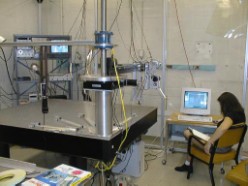CDF
CDF Experiments at Fermilab
Faculty:
Graduate Students:
- John Strologas - Research Associate Professor
- Marcelo Vogel - marcvog@unm.edu
The CDF group at the University of New Mexico (UNM) collaborates with major experimental high energy physics groups in Canada, Germany, Italy, Japan and the US, to carry out experiments with the ultra-sophisticated CDF detector at the Tevatron collider at Fermilab near Chicago. The CDF collaboration dominates the physics program at the Tevatron: the highest energy collider in the world. The CDF program emphasizes physics at the highest energies/mass scales as this physics is accessible only to the Tevatron experiments. This includes studies of the top (t) quark, and searches for new physics beyond the Standard Model including quark compositeness, supersymmetry (SUSY), new massive gauge bosons, etc.. The large B cross section at the Tevatron, combined with the precision vertex detector in CDF that is used to tag B decays, has resulted in a rich program of B physics. Current physics analyses include studies of/searches for B** mesons, rare B-decays, and the SUSY top squark, as well as a new measurement of the the top quark cross section and the strong coupling constant.
The CDF experiment is one component of the nuclear, particle and particle-astrophysics programs of the New Mexico Center for Particle Physics in the Department of Physics and Astronomy at the University of New Mexico, Albuquerque, NM 87131, USA.
